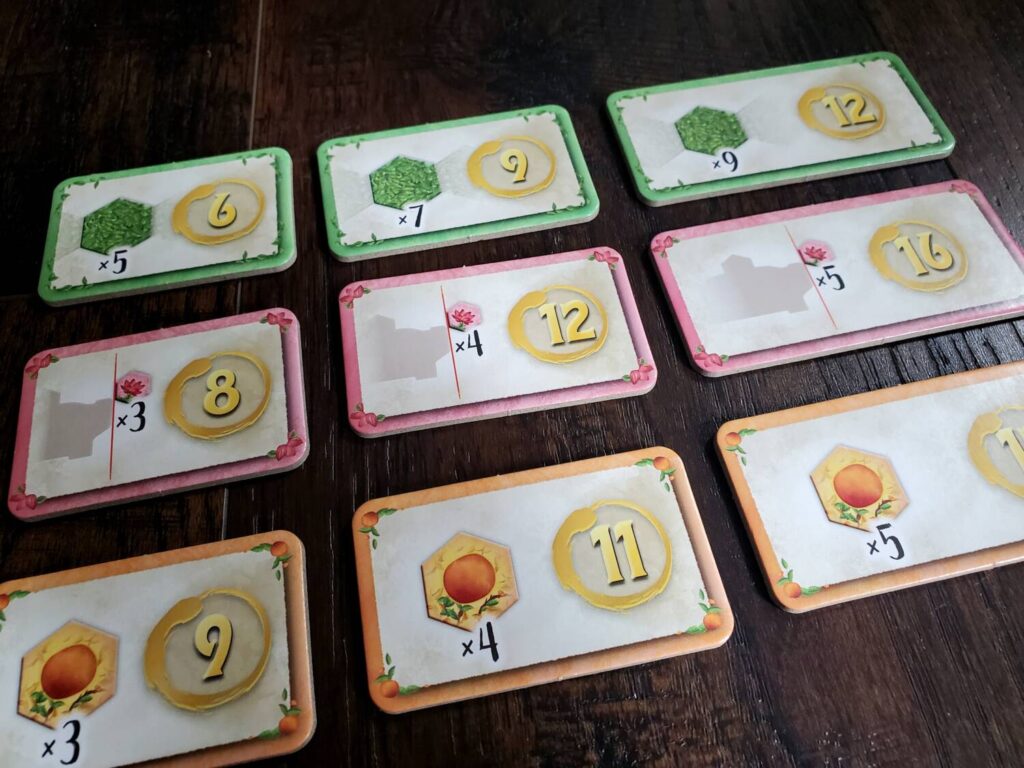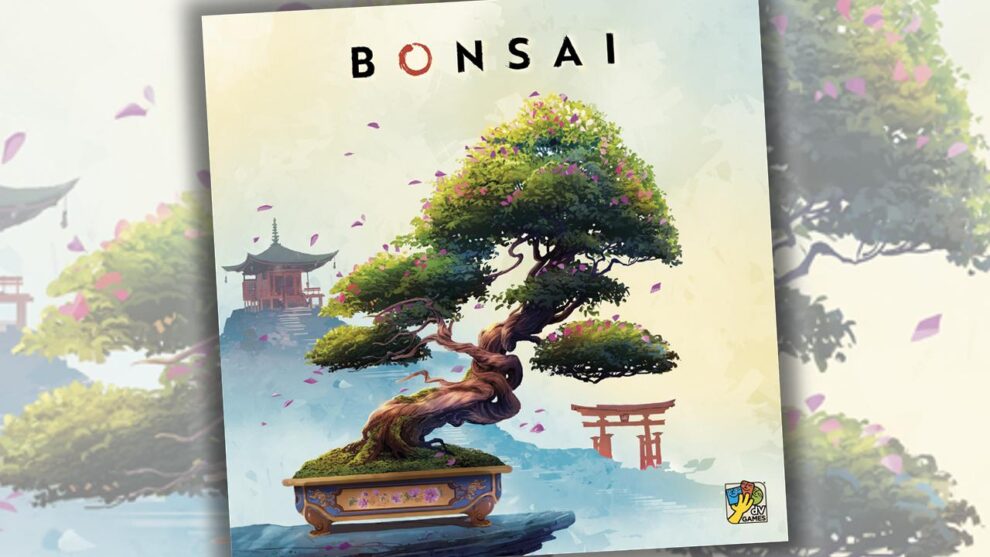Disclosure: Meeple Mountain received a free copy of this product in exchange for an honest, unbiased review. This review is not intended to be an endorsement.
I had a bonsai tree once. It was a gift that, unfortunately, didn’t survive long enough to discover its character. My black thumb may have killed the tree, but it didn’t quell my appreciation of the artistic impulse responsible for the little potted personalities.
Bonsai are surprisingly hardy, a testimony to my inability to care for green things. Cardboard, thankfully, is already dead and happily hardy, which elevated my hopes for Bonsai from DV Games. Rosaria Battiato and Massimo Borzì have teamed up with Martino Chiacchiera to bring an innovative aesthetic idea to the table in which players create bonsai from hex tiles to meet various scoring criteria.
The Moyoji?
The bonsai container, complete with a touch of Kintsugi, begins with a stump. Players visit the market—an action referred to as “meditation”—to acquire cards, gathering hex tokens in tow. The tokens feature wood, leaves, flowers, and fruit, destined to become part of the tree during a cultivation turn.

At the outset, players are restricted to storing five tiles and cultivating three at a time. In addition to expanding these capacities, the cards grant extra tiles, allow for untimely cultivation, or provide endgame scoring bonuses (related to the cards collected). As the cards slide through the market, each slot is marked with a distribution of tiles (or none). These shifting combinations create tension in the decision space as players weigh needs with opportunities, measuring their patience against the expected needs of the opposition.
Cultivation turns bring the bonsai vision to life, three or more tiles at a time. The trees grow according to common sense: wood upon wood, leaves from wood, flowers from leaves, fruit touching multiple leaves. Several scoring indicators guide the process. Wood scores nil, leaves score three. Flowers score a point for each exposed side of the hex. Fruit score per piece. Atop these basic aims, three graduated goals provide the final bit of tension.

The graduated goals, chosen at the beginning, encourage horticultural habits, but with an agonizing twist. Having three tiles that reward eight, ten, or twelve points is nothing interesting. But when you reach a specific goal—three fruits, perhaps—you must decide in the moment whether to accept the reward or renounce it in the name of pursuing the next tier. Of course, you cannot fall back on renounced aims and you can only claim one, so you’re always evaluating your level of satisfaction with the project against the realm of possibility.
The deck is a timer, triggering the end when the cards run out. There’s a scorepad in the box to add up a decent amount of points—scores easily climb over 100.
The Kengai
Bonsai is a breezy experience: take a card or cultivate the tree. The simplicity is necessary for a game of this sort, the quintessential low-pressure play. There are no real consequences here. You might just ignore the goals if you’re in the mood to craft something that’ll please the eye. In that I am reminded of a game like Canvas—one that prizes craft alongside victory, sometimes to the exclusion of victory altogether. It’s normal to spend a moment admiring the trees before boxing it up.
This draw toward an attractive end is both the greatest strength and the most glaring missed opportunity. Bonsai is the sort of game you might play with people who don’t really play games. Not only is it easy to learn and largely without sweaty stress, but you finish with a sense of accomplishment at having built something quite pretty. I can’t ask for more when I’m having dinner with friends who aren’t looking to give their life to the hobby. Card games often suit best, but the tiny trees are nice if folks are not averse to 30 or 40 minutes of creative competition.

But goodness, there’s a set of cards missing here! I can only hope there are a dozen or more pattern cards in the pipeline as an expansion pack or a promo release. I understand that bonsai are meant to chart their own path, become their own creature, but the game would benefit immensely from a deck presenting aesthetic elements to incorporate into play. Maybe a fully surrounded hole in the layout, or symmetries for bonus points. Creating a near-ring of flowers, or keeping the leaves entirely atop or underneath the branches would be interesting. Rather than the stairstep goals mostly based on quantity, I would love another layer devoted to beauty. Two of the graduated goals involve placing elements beyond the rim of the pot, but these hints only scream the potential of a more challenging and satisfying set of objectives that is yet to exist.
I think of Sagrada with its multi-tiered objectives, patterns private and public. Bonsai could even dabble in this concept without inducing half the stress of the dice (though I am a huge fan of the dice). No matter the type or aim, the trees are a fertile ground for one more available challenge to tickle the green thumbs of the gamer types.
Even without, I would call Bonsai a welcome addition to the shelf. The game has already been in my life longer than that gifted tree. Our children love it. The adults have enjoyed the light puzzle. It works at every player count and it’s back in the box in well under an hour even with the teach. The one complaint that surfaced is that it’s almost too short a game. Sometimes the deck runs out, leaving you wishing for another two or three rounds to make more of your tree. But I’ll take the brevity.

There aren’t too many surprises in the mechanics. There’s an enjoyable balance between chasing the tree itself and chasing combinations of cards. As a motif, it’s been done before; but it’s done well here. Likewise, deciding whether to select a card for its benefit or the card that scores for the presence of the very card you must forgo to claim those points? Nice.
The rulebook, in addition to being supremely well organized, is also informative. The final pages are dedicated to bonsai education, tying many of the game’s mechanical efforts and aesthetic choices to the actual care and cultivation of the trees. The game box is the right kind of sturdy, a little oversized but stunning to match the game’s visual goodness.
It’s so unique on the table that it demands a bit of attention. When I saw Bonsai before SPIEL in 2022, I was immediately interested. I said it looked like a peaceful, easy feeling. I was right. I also said it looked like a slice of something beautiful. I think I was right there as well. Ultimately it’s the quirky hex-beauty that makes Bonsai a worthy exploration.












Add Comment